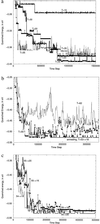Linking topography of its potential surface with the dynamics of folding of a protein model
- PMID: 9275155
- PMCID: PMC23210
- DOI: 10.1073/pnas.94.18.9520
Linking topography of its potential surface with the dynamics of folding of a protein model
Abstract
The "3-color, 46-bead" model of a folding polypeptide is the vehicle for adapting to proteins a mode of analysis used heretofore for atomic clusters, to relate the topography of the potential surface to the dynamics that lead to formation of selected structures. The analysis is based on sequences of stationary points-successive minima, joined by saddles-that rise monotonically in energy from basin bottoms. Like structure-seeking clusters, the potential surface of the model studied here is staircase-like, rather than sawtooth-like, with highly collective motions required for passage from one minimum to the next. The surface has several deep basins whose minima correspond to very similar structures, but which are separated by high energy barriers.
Figures



References
-
- Ball K D, Berry R S, Proykova A, Kunz R E, Wales D J. Science. 1996;271:963–966.
-
- Kunz R E, Berry R S. J Chem Phys. 1995;103:1904–1912.
-
- Kunz R E, Berry R S, Astakhova T. Surf Rev Lett. 1996;3:307–312.
-
- Kunz, R. E., Blaudeck, P., Hoffmann, K. H. & Berry, R. S. (1997), in press.
-
- Vekhter B, Ball K D, Rose J, Berry R S. J Chem Phys. 1997;106:4644–4650.
Publication types
MeSH terms
Substances
LinkOut - more resources
Full Text Sources

